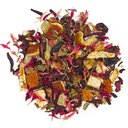Hibiscus Tea
Wikipedia: Hibiscus_tea | Teaviews: hibiscus-teaLast Updated: May. 4, 2018
↑About Hibiscus Tea
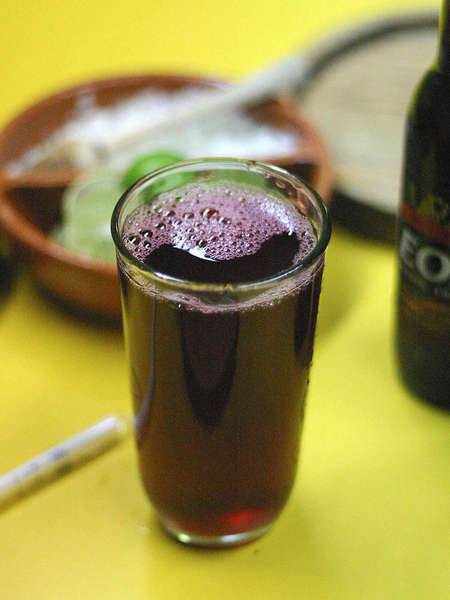 Glass of Hibiscus Tea or Agua de Jamaica, Photo © Meutia Chaerani / Indradi Soemardjan, CC BY-SA 3.0.
Glass of Hibiscus Tea or Agua de Jamaica, Photo © Meutia Chaerani / Indradi Soemardjan, CC BY-SA 3.0.Although the dried tea looks like it is made from petals, it is actually made from the sepals (calyces), the small structures at the base of the flower. Many species of hibiscus are grown ornamentally, but the species Hibiscus sabdariffa (also known as roselle) is the most common one used in herbal teas. Chinese hibiscus, or Hibiscus rosa-sinensis, is also sometimes used to produce herbal teas, but this article focuses on the sabdariffa species.
The roselle species can be grown commercially, as a perennial, in hot tropical areas, or as an annual in colder climates. Hibiscus tea is produced only from certain cultivars or varieties of Hibiscus sabdariffa; other cultivars of this plant are used to produce fiber, or for ornamental purposes such as landscaping and gardening.
Hibiscus is also one of the most common ingredients in herbal blends; it even occurs as the main ingredient in many herbal blends widely available in supermarkets in the U.S. Hibiscus is rather acidic, and its most common use in blends is to impart a sour taste and dark red or purple color, although it also imparts aroma as well.
A drink of many names
Hibiscus tea is widely consumed as a drink on its own from Southeast Asia to Africa and the Caribbean; each of these regions puts their own unique twist on how the drink is prepared. In Latin America, the drink is known as agua de flor de Jamaica, sometimes shortened to agua de Jamaica, rosa de Jamaica, or just Jamaica. In Panama, hibiscus tea is called saril. In North Africa, especially Egypt, the drink is called karkadé(كَركَديه) which just means hibiscus in Arabic; this region has a long history of the use of this drink.In some regions, hibiscus is also blended with black tea.
Medicinal uses and health benefits of hibiscus tea
Hibiscus tea has traditionally been used to treat hypertension (high blood pressure), lower fever, and treat liver disorders. Hibiscus is also rich in vitamin C and other antioxidants.A human study has validated that hibiscus tea, in an amount easily incorporated into the diet, is effective at lowering blood pressure in people suffering from hypertension[1]. The extract of the hibiscus sabdariffa plant has been studied more extensively and compared to various drugs used to lower blood pressure: it was found in a 2004 study to be roughly comparable in effect and tolerability to captopril[2], and a 2007 study found it to be less effective than lisinopril, but it showed 100% tolerability (absence of intense side effects) in this study[3]. It is likely that hibiscus acts to lower blood pressure through being an ACE inhibitor.[3]
There is evidence both from studies on rats and rabbits, and more recently, human studies, that hibiscus sabdariffa can lower cholesterol levels[4].
Studies in mice and rats have also validated that hibiscus has a fever-lowering (antipyretic) effect, and the evidence suggests that the mechanism by which it acts is different from that of aspirin.[5]
A study in mice found that hibiscus sabdariffa can prevent liver damage caused by acetaminophen, the active ingredient in Tylenol and a number of other pain-killers, which is known to cause liver damage in high enough doses.[6]
References:
1. Diane L. McKay et. al., Hibiscus Sabdariffa L. Tea (Tisane) Lowers Blood Pressure in Prehypertensive and Mildly Hypertensive Adults, Journal of Nutrition, Vol. 140, No. 2, pp. 298-303, Feb. 2010.
2. A. Herrera-Arellano, et. al., Effectiveness and tolerability of a standardized extract from Hibiscus sabdariffa in patients with mild to moderate hypertension: a controlled and randomized clinical trial., Phytomedicine, Vol. 11, No. 5, pp.375-82. Jul. 2004.
3. A. Herrera-Arellano, et. al., Clinical effects produced by a standardized herbal medicinal product of Hibiscus sabdariffa on patients with hypertension. A randomized, double-blind, lisinopril-controlled clinical trial., Planta Med; Vol. 73, No. 1, pp. 6-12, Jan. 2007.
4. Tzu-Li Lin et. al., Hibiscus sabdariffa extract reduces serum cholesterol in men and women, Nutrition Research, Vol. 27, No. 3, pp. 140-145, Mar. 2007.
5. Wantana Reanmongkol, Arunporn Itharat, Antipyretic activity of the extracts of Hibiscus sabdariffa calyces L. in experimental animals, Songklanakarin Journal of Science and Technology, Vol. 29, Suppl. 1, pp. 29-38, 2007.
6. Liang-Chi Liu et. al.,
Aqueous extract of Hibiscus sabdariffa L. decelerates acetaminophen-induced acute liver damage..., Journal of the Science of Food and Agriculture, Vol. 90, No. 2, Jan. 2010, pp. 329-337.
↑Recent Hibiscus Tea Reviews — RSS 
Interesting option for a quick cold brewed tea.
Aroma: faint, very faint peach notes and almost nothing else. I almost want to try this with sparkling water to see if it pops more.
Flavor: very mild peach ring notes. Not too sweet. Thin body.
Value: fairly expensive shelf tea. Wouldn’t recommend.
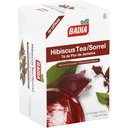
Hibiscus Tea / Sorrel (Té de Flor de Jamaica) from Badia
Style: Hibiscus Tea – Region: ?????Jun. 4th, 2019
Good quality, straightforward hibiscus flower tea. Bulk hibiscus flowers are cheap, but quality can be hit or miss. Though many (or even most) blended herbal teas contain hibiscus, few brands offer unblended hibiscus teabags and the ones that do tend to be overpriced.
Hibiscus is tart and fruity, almost like unsweet...
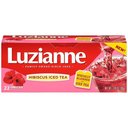
I am a lifelong drinker of black iced tea (Luzianne)). When I need to cut back my caffeine intake later in the day so I am not kept awake, I switch to Luzianne's new Hibiscus Iced Tea. When prepared according to directions, it produces a deep red, rich tasting tea that never clouds up even when refrigerated or kept ove...
Read Full Review
Hibiscus Tea / Sorrel (Té de Flor de Jamaica) from Badia
Style: Hibiscus Tea – Region: ?????Jul. 15th, 2015
Delightful tea made from the dried calyx of a hibiscus-type plant. The taste is floral and citrus and the color is ruby red. Red Zinger tea is the name given by Celestial Seasonings but Badia's is much nicer in my opinion.
Online you can find recipes to make a Jamaican version of this tea adding ginger and other her...
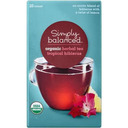
Yummy! It's a beautiful red color, the aroma is nice, and the flavor isn't too astringent for being mostly hibiscus - it's summery and tropical and fresh. I brewed the first cup for a little less than three minutes, and got a decent second cup out of it.
Read Full ReviewRead More Reviews of Hibiscus Tea (13) ...
↑Top Reviewers
| Rank | User | # | % |
| 1 | 4 | 9 | |
| 2 | 1 | 2 | |
| 3 | 1 | 2 | |
| 4 | 1 | 2 | |
| 5 | 1 | 2 |
Review 2 teas to get on this list!
Advertisement
↑Most-Rated Hibiscus Tea

Tropical Hibiscus Herbal Tea
| Brand: | Simply Balanced |
| Style: | Hibiscus Tea |
| Region: | ????? |
| Caffeine: | Caffeine Free |
| Leaf: | Teabag |

Hibiscus Tea / Sorrel (Té de Flor de Jamaica)
| Brand: | Badia |
| Style: | Hibiscus Tea |
| Region: | ????? |
| Caffeine: | Caffeine Free |
| Leaf: | Teabag |

Hibiscus Flowers, Coarse Cut
| Brand: | Upton Tea Imports |
| Style: | Hibiscus Tea |
| Region: | Nigeria |
| Caffeine: | Caffeine Free |
| Leaf: | Loose |

Hibiscus Iced Tea
| Brand: | Luzianne |
| Style: | Hibiscus Tea |
| Region: | ????? |
| Caffeine: | Caffeine Free |
| Leaf: | Teabag |
↑Top-Rated Hibiscus Tea

Tropical Hibiscus Herbal Tea
| Brand: | Simply Balanced |
| Style: | Hibiscus Tea |
| Region: | ????? |
| Caffeine: | Caffeine Free |
| Leaf: | Teabag |







